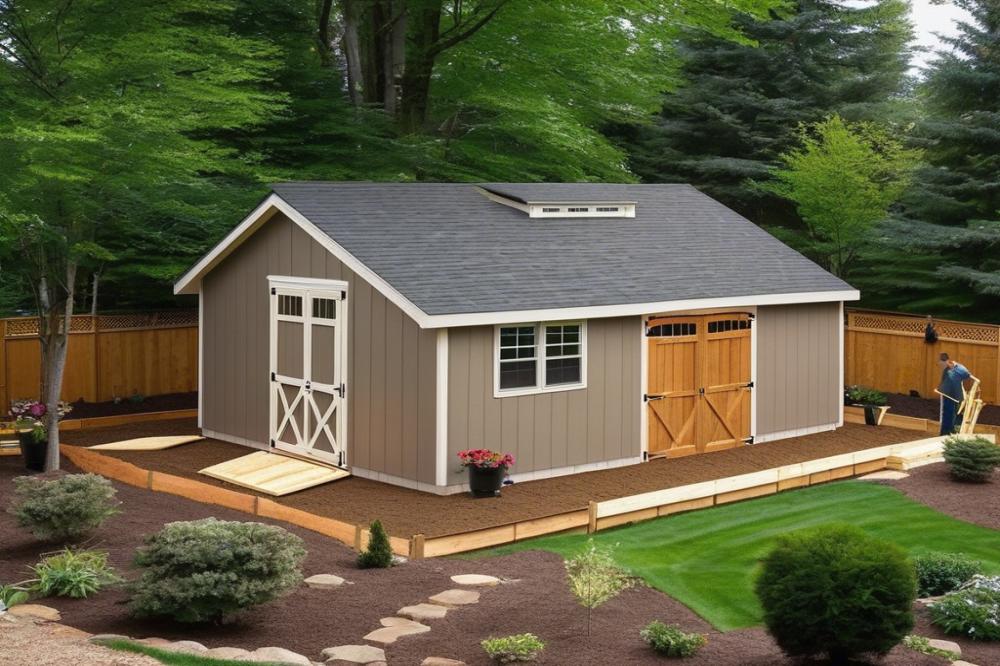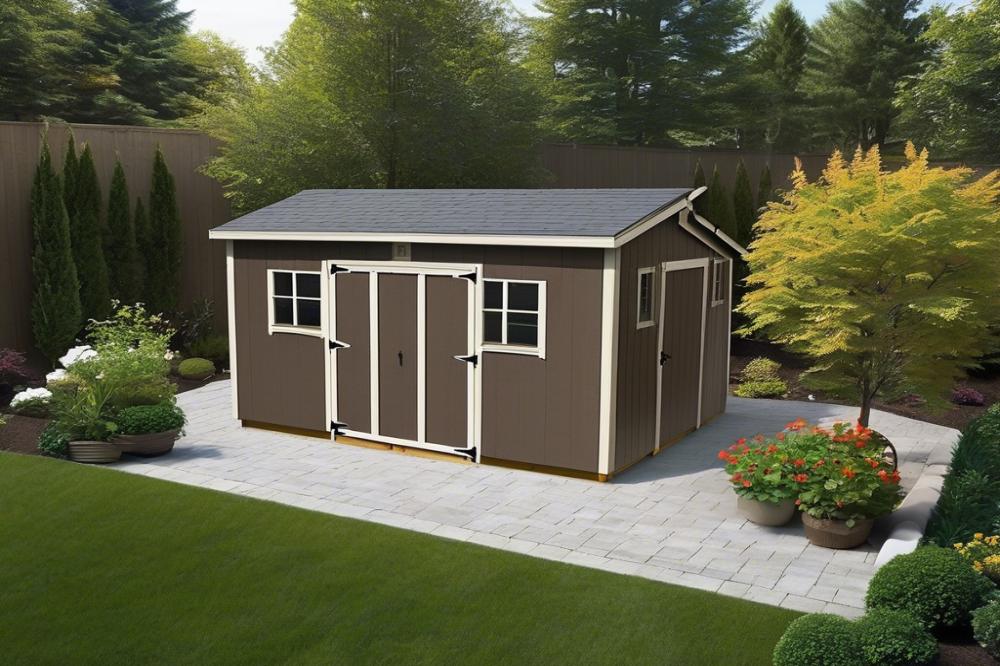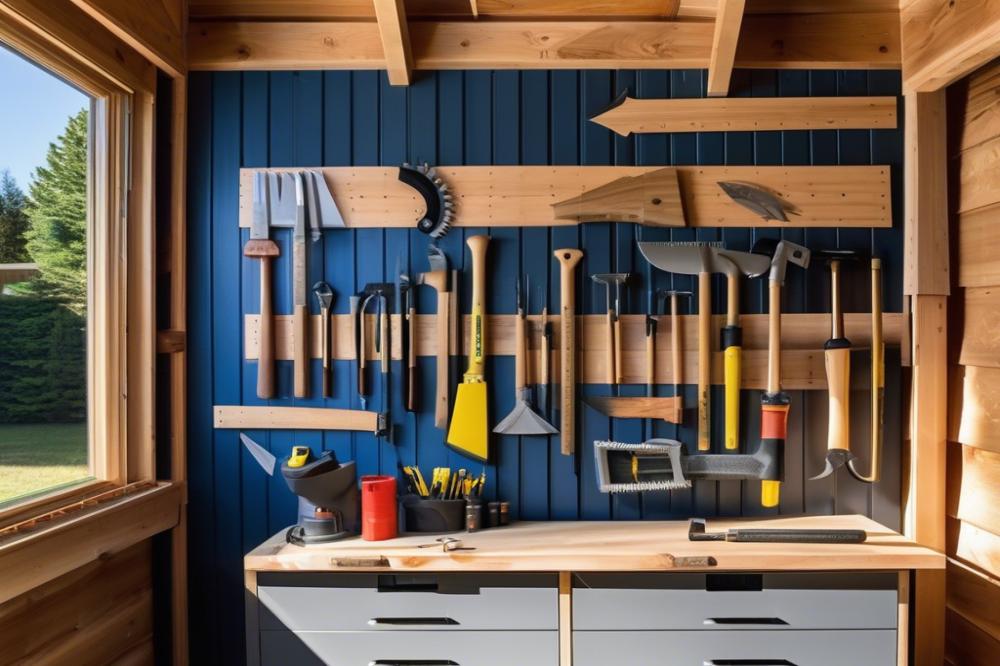Understanding shed construction
The art of building a shed encompasses various techniques and skills. Initiating this process may seem daunting, but understanding the basics simplifies it. Achieving a sturdy structure requires proper framing. shed walls and roofs must be designed with care to function effectively. Attention to detail will lead to a successful DIY shed project.
Framing is crucial for the overall stability. Without a strong frame, the entire structure can be compromised. Good framing techniques offer not just strength, but also facilitate insulation and ventilation. Properly installed insulation keeps the shed comfortable, while ventilation prevents moisture buildup. These elements contribute to the shed’s longevity.
When considering shed design, visualize the intended use of the space. Some people need storage, while others may wish for a workshop or a garden retreat. Selecting the right construction materials affects both appearance and durability. Wood, metal, or plastic can fit different needs and preferences. Structural integrity stems from these thoughtful decisions.
Planning is just as important as building. Effective layouts should incorporate not only walls and roofs but also windows and doors for functionality and aesthetic appeal. Various shed designs can transform a simple structure into an enriching space. Understanding these basics leads to a more successful project, whether for personal use or added property value.
shed framing

shed framing is a critical aspect of building any structure. It involves creating the support system for your shed walls, roofs, and more. This framework holds everything together and gives the shed its shape. Proper framing helps maintain the structural integrity of the entire building. It also plays a vital role in the overall shed design, affecting how well the space functions.
Key components are essential to a strong frame. Studs, which are vertical supports, form the walls. They connect with horizontal pieces known as plates. Roof rafters provide support above, holding up the shed roofs and maintaining the shape of the structure. Adding proper insulation and ventilation in the framing phase can make your shed more comfortable and functional. Choosing the right construction materials is important for durability.
When considering basic framing techniques for DIY shed builders, start with a solid plan. Draw out the shed design before cutting any wood. A clear vision will guide your work. Cut your studs and plates to the desired lengths to form walls. Use a level to check that everything is straight as you build. When framing the roof, ensure the rafters are spaced correctly. Improper spacing can lead to weak spots. Each step in woodworking needs attention to detail to prevent issues later.
Furthermore, consider any additional features you might want. Windows or vents can improve air circulation within the shed. Think about how these elements affect your framing layout. Keep track of your measurements; accuracy is key throughout the process. Lastly, remember that building a solid frame takes time and patience. Rushing can lead to mistakes that might compromise your project.
Shed Walls

Materials Used for Shed Walls
A variety of construction materials can be used for shed walls. Plywood and oriented strand board (OSB) are popular choices. Both are strong and provide good structure. For a more traditional look, some might opt for cedar or pine boards. Metal siding also offers durability and weather resistance. Selecting the right material impacts the overall shed design.
Common Wall Framing Methods
Framing techniques vary based on the style and function of the shed. The simplest method is the post-and-beam approach. This involves vertical posts and horizontal beams, providing a sturdy structure. Another common technique is the use of wooden studs, which can create enclosed spaces for storage. Each method has its benefits and helps maintain structural integrity.
Insulation Options and Their Benefits
Insulation is crucial for maintaining a comfortable temperature inside the shed. Fiberglass insulation is affordable and easy to install. Spray foam insulation can provide a tighter seal, preventing drafts. Reflective insulation is another option, especially for hotter climates. Insulated shed walls help conserve energy and can protect stored items from extreme temperatures.
Importance of Ventilation in Wall Design
Ventilation should not be overlooked in wall design. It helps prevent moisture buildup, which can lead to mold and rot. Proper airflow supports the longevity of the materials used in construction. Adding vents or small windows can improve air circulation. Ensuring the walls allow fresh air in contributes to a healthier environment inside the shed.
Shed Roofs

Types of shed roofs and Their Framing Requirements
Several types of shed roofs exist, each offering different benefits. The flat roof is simple to construct but requires careful drainage planning. Gable roofs feature two sloping sides, allowing for better water runoff. Hip roofs have slopes on all sides, providing good stability in windy areas. Each design has unique framing techniques. For example, gable roofs need rafters at angles to hold the structure together.
Materials for Roofing Structures
Choosing the right construction materials is crucial for a sturdy shed. Common options include wood, metal, and asphalt shingles. Plywood can serve as a solid base, while metal roofing offers long-lasting protection. Consider weight and durability when selecting materials. Wood should be treated to withstand moisture.
Techniques for Ensuring Durability and Weather Resistance
Proper framing techniques play a significant role in a shed’s lifespan. Sealing joints with caulk can prevent water leaks. Installing flashing around edges helps redirect rain away from critical areas. Regular maintenance, such as checking for signs of wear, keeps the shed safe. Additionally, using high-quality roofing materials can guard against harsh weather conditions.
Importance of Proper Insulation and Ventilation in Roofs
Good insulation is essential for maintaining a comfortable environment inside the shed. It helps regulate temperature, making the shed usable year-round. Ventilation is equally important as it allows moisture to escape, reducing the risk of mold. Design features, like vents or gable windows, promote airflow. Together, insulation and ventilation help preserve the structural integrity of your shed.
Construction Materials

When embarking on a DIY shed project, selecting the right construction materials is essential. Several options are available, each bringing unique advantages and challenges. The most common materials include wood, metal, and composite materials. Understanding their characteristics can help you make informed choices for your shed walls, roofs, and overall design.
Overview of Common Materials Used in shed construction
Wood remains a popular choice due to its availability, ease of working, and aesthetic appeal. It lends itself well to various framing techniques, making it ideal for woodworking enthusiasts. Many choose wood for the warmth it provides, both in appearance and insulation. Metal, on the other hand, offers durability and strength. With proper treatment, it can withstand harsh weather conditions and resist rot and pests. Composite materials combine the best attributes of wood and plastic. They are designed to mimic the look of wood while providing better resistance to warping, fading, and insects.
Comparison of Wood, Metal, and Composite Materials
Each material has its pros and cons. Wood is versatile and easy to modify, but it requires regular maintenance to ensure longevity. Metal requires less upkeep, but it can be prone to rust if not treated properly. Various finishes can enhance its resilience against corrosion. Composite materials provide a great middle ground, offering low maintenance along with a wood-like appearance. However, they can be more expensive than traditional options.
When it comes to shed roofs, each material behaves differently. Wood can be used for traditional sloped roofs, allowing for various styles. Metal roofs, while often louder during rain, boast impressive lifespans with proper care. Composite roofing materials provide a stylish look while ensuring long-term performance.
Considerations for Choosing the Right Materials for Walls and Roofs
Several factors should guide your material selection process. Think about the climate in your region. In areas prone to heavy snow, structural integrity becomes crucial, making metal or engineered composites viable options. Insulation and ventilation are also key considerations, especially if you plan to use your shed for specific activities. A well-insulated structure provides comfort for storage or hobby work.
Budget plays a significant role too. Costs can vary widely among wood, metal, and composite materials. Additionally, consider the time and skill you possess for construction. If you are less experienced in woodworking or framing, simpler materials might make your project easier to manage. Always research local codes and regulations, as they can dictate acceptable materials for your shed design.
Framing Techniques
Understanding various framing styles is essential for building any structure, including a DIY shed. Two common styles are platform framing and post-and-beam framing. Platform framing is popular in residential construction. Each floor is built separately and stacks on the one below. This method is efficient, allowing for easier insulation and ventilation placement.
On the other hand, post-and-beam framing uses larger wooden posts and beams to support the structure. This design creates an open floor plan with fewer interior walls. Post-and-beam often provides a unique aesthetic but may require more skill and precision in woodworking.
To achieve structural integrity, best practices must be followed. Using high-quality construction materials can greatly affect the strength of your building. Always check for straightness in your lumber before use. Ensure all joints are tightly fitted together to avoid future issues.
When framing shed walls and roofs, pay attention to the connections between beams and posts. Proper nailing techniques and angles will provide added strength. Check local building codes as they often provide guidelines on spacing and materials. Meeting these regulations can prevent potential problems down the road.
For novice woodworkers, tackling framing can seem intimidating. Start by reading up on various techniques and practicing with scrap wood. Familiarize yourself with tools like saws, drills, and levels. Each tool serves a specific purpose that is crucial during construction. Don’t hesitate to ask for help if you encounter challenges.
An important tip is to measure twice before cutting once. This helps to avoid wasting materials, which can be costly. Sketch out your shed design ahead of time, noting dimensions clearly. Visual plans can simplify complex steps in the woodworking process.
Finally, remember to take your time. Rushing through framing can lead to mistakes that compromise the overall stability. Learning how to frame correctly will provide a solid base for your DIY shed that can stand the test of time.
Shed Design
Several factors influence shed design and layout. First, consider the purpose of your shed. Will it be a storage space, a workshop, or maybe a garden potting area? Each of these functions demands different dimensions and features. Additionally, the size of your property plays a role. A larger yard can accommodate a more extensive structure, while a cozy backyard may require a compact design.
Building a shed is not just about nailing some walls together. The role of functionality in shed construction cannot be overlooked. For instance, if you are planning to work with power tools inside, adequate insulation and ventilation are vital. Proper airflow helps avoid overheating and keeps the shed comfortable. Think about the type of construction materials, as the right choices will affect durability and usability.
Customizing your DIY shed allows you to meet your personal needs perfectly. You might want to add shelves, benches, or special storage areas for tools. Framing techniques can vary based on how you envision the layout. You could opt for tall shed walls if you plan to build overhead storage. Consider windows for natural light or extra ventilation. Choosing the right location is also crucial; placing your shed in a shaded area can help keep it cool during hot days.
Every shed project offers unique opportunities for creativity. If woodworking is your passion, why not incorporate intricate designs or features? A distinctive roof shape could add character to your shed, while also ensuring structural integrity. You could even think about incorporating a green roof if you’re feeling adventurous. It may take more planning, but it can be remarkably rewarding.
Ultimately, your shed is a reflection of your needs and preferences. Making it truly yours might involve some extra effort, but the results are worth it. Personal touches like color schemes, door styles, or even decorations can make a big difference in the overall feel. Intrigued? Let your imagination guide you as you dive into this project.
Wrapping Up Your Shed Project
In summary, understanding the key concepts behind constructing frames, walls, and roofs is essential in building a successful shed. Each element plays a critical role in the overall stability and appearance of your structure. Remember, sturdy shed walls provide support and protection from the elements. Similarly, well-constructed shed roofs not only keep water out but also enhance the shed’s aesthetic appeal.
For all the DIY enthusiasts out there, now is the perfect time to put your newfound knowledge to work. Don’t hesitate to dive into your projects. Hands-on experience is the best teacher. Use the tips from this article to guide you, but also trust your instincts. Each shed you build can be a learning opportunity. Take pride in your work, and enjoy the process of creating something unique.
Ultimately, careful planning and execution are vital to the success of any construction project. Jot down your ideas and designs before you start. Measure twice and cut once to minimize mistakes. A thoughtful approach will lead to better results. In the end, the effort you put into building will reflect in the quality and longevity of your shed.



